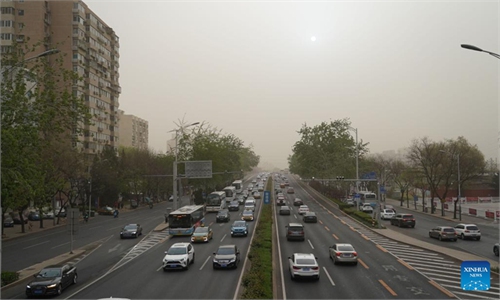Two strongest dusty weather periods this year originate mainly from Mongolia: National Meteorological Center

A woman wearing a face mask walks on an overhead bridge in the central business district as dust and sand storm sweeps through Beijing, on April 13, 2023. Photo: VCG
Official data showed that the two strongest periods of dusty weather in March and April this year mainly originated from Mongolia, with the main sand source more than 600 kilometers away from Beijing, leading the air quality in the capital to reach the level of serious pollution, according to China's National Meteorological Center (NMC) on Friday.
Since April 8, the national observatory issued sandstorm alerts for seven consecutive days, warning local residents that billowing dust was expected to hit more than a dozen provinces and regions across China. The two dusty weather periods of March 19 to 23, and April 9 to 13 both originated mainly in Mongolia, said the NMC.
China's National Meteorological Center lifted a blue alert for sandstorms at 6 pm on Friday.
A few media outlets in South Korea and Japan reported that the dust has spread to their countries, impacting people's lives.
Chinese Foreign Ministry spokesperson Wang Wenbin said at Thursday's regular press briefing that in recent years, China has taken desertification control very seriously, and notable progress has been achieved through years of efforts. The areas of desertified and sandified land have shrunk for four consecutive monitoring periods.
From 2000 to 2022, a total of 307 dusty weather periods occurred in China, with an average annual occurrence of 13.35 times. In 2014, there was the least at only seven times, while 2001 saw 22 periods of dusty weather.
However, the frequency and intensity of the dusty weather decreased significantly after 2011, with the annual average frequency during the period of 2011 to 2022 being 11.17, and for sandstorms it was just three times, according to the NMC.
More than 70 percent of the dust days in China occur in spring, with April being the worst month, followed by March and May.
There have been eight dusty weather periods this year in the country, which is the most in the last decade, with the dusty weather occurring earlier and more frequently, mostly in March.
The dusty weather occurred on January 12 for the first time this year, 32 days earlier than in recent years. Also, China experienced six dusty weather periods in March, one more than the usual five times in recent years.
The repeated dusty weather this year once again shows that stepping up sand control, conducting multi-pronged science-based desertification control, enhancing ecological conservation and building a beautiful China remain uphill and long-term tasks that call for persistent and unremitting efforts, Wang said.
China's efforts to combat desertification and control air pollution have not only benefited its people, but also contributed enormously to the air quality in Northeast Asia as a whole, Wang noted.
Wang said that China will continue to implement its national plan for sand control covering the period from 2021 to 2030, ensure effective desertification control at home, and make efforts to contribute to global sandstorm prevention and control.
Global Times



